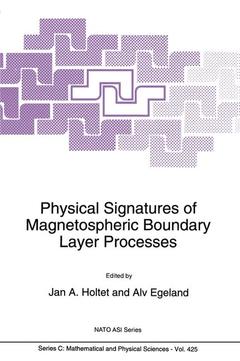Description
Physical Signatures of Magnetospheric Boundary Layer Processes, Softcover reprint of the original 1st ed. 1994
Nato Science Series C: Series, Vol. 425
Coordinators: Holtet J.A., Egeland A.
Language: English
Subjects for Physical Signatures of Magnetospheric Boundary Layer...:
Keywords
Absorption; HTS; Ionosphere; Magnetosphere; Precipitation; Scale; Wind
Publication date: 10-2012
456 p. · 16x24 cm · Paperback
456 p. · 16x24 cm · Paperback
Description
/li>Contents
/li>
Summary of the NATO Advanced Research Workshop on Physical Signatures of Magnetospheric Boundary Layer Processes T A POTEMRA, M I PUDOVKIN, R W SMITH, V M VASYLIUNAS and A EGELAND 451 PREFACE These proceedings are based on the invited talks and selected research reports presented at the NATO Advanced Workshop on "PHYSICAL SIGNATURES OF MAGNETOSPHERIC BOUNDARY LAYER PROCESSES", held at Sundvolden Hotel, Norway, 9.-14.May 1993. The international political and scientific communities have gradually realized that the Earth's environment is more fragile than previously believed. This has led to the establishment of international research programmes directed toward the understanding of "Global Change". The Earth's magnetosphere, "the Earth-space", is a part of our environment, and physical processes in the magnetosphere and coupling between the solar energy stream, the solar wind, and the Earth-space are important in the complete understanding of our environment. Variations in the electromagnetic and particle energy output of the Sun have a significant effect on global changes. The energy transfer mechanisms at the days ide magnetospheric boundary layers and their ionospheric signatures are perhaps even more important to solar terrestrial research than the night-side processes in this connection. The dayside boundary layers and the polar cusps are the Earth's windows to outer space. The present NATO ARW was the latest in a series of conferences focused on dayside magnetospheric phenomena. It is five years since the preceding Workshop on "Electromag netic Coupling in the Polar Clefts and Caps" was held at Lillehammer in September 1988.
I Currents, Electric Fields and Particles.- Sources of large-scale Birkeland currents.- Solar wind control of high latitude dayside current systems.- Thermal ion drifts in the dayside high-latitude ionosphere.- Signatures and sources of electric fields and particles at dayside high latitudes.- Viking observations of dayside high-latitude electric fields.- The projection of the magnetospheric boundary layers to mid-altitudes.- Classification of large-scale and meso-scale ion dispersion patterns observed by Viking over the cusp-mantle region.- Electrodynamic signatures of the plasma sheet boundary layer in the evening ionosphere.- Progressing dayside polar radio wave absorption events and convection disturbances.- II Dayside Aurora.- Dayside aurora and magnetopause processes.- Space borne optical remote sensing of midday auroral oval and different participation regions.- Cusp/cleft auroral activity in relation to solar wind dynamic pressure, IMF Bz and By.- Dayside aurora poleward of the main auroral distribution: Implications for convection and mapping.- Dayside auroral dynamics during reconfiguration of the auroral oval.- Poleward-moving auroral forms: What do we really know about them?.- III Solar Wind- Magnetosphere Coupling.- Ionospheric signatures of pulsed magnetopause reconnection.- Magnetosheath fluctuations, ionospheric convection and dayside ionospheric transients.- Concerning the location of magnetopause merging.- Transient dayside reconnection and its effects on the ionosphere.- Patchy multiple X-line reconnection and poleward-moving auroral forms.- Influence of the IMF sector structure on the latitude of the daytime cusp region.- Another look at flux transfer events.- IV Waves.- MHD theory of magnetic pulsations.- ULF waves in the cusp and cleft: Signaturesof boundary layer processes.- Optical evidence that modulated electron precipitation near the magnetospheric boundary drives high latitude Pc 3–4 magnetic pulsations.- The ULF modulation of ELF-VLF emissions close to the magnetospheric boundary.- V Modelling and Mapping.- A quantitative model of magnetosheath plasma in the low latitude boundary layer, cusp, and mantle.- Application of the assimilative mapping of ionospheric electrodynamics (AMIE) procedure to cusp identification.- A model of the magnetosheath and dayside magnetopause and their coupling to the cusp/cleft ionosphere.- New methods and techniques in visualization and mapping of magnetospheric boundaries.- Summary.- Summary of the NATO Advanced Research Workshop on Physical Signatures of Magnetospheric Boundary Layer Processes.
© 2024 LAVOISIER S.A.S.




